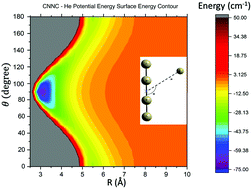Electronic structure calculations and quantum dynamics of rotational deexcitation of CNNC by He†
Abstract
The quantum dynamics of rotational transitions of the diisocyanogen (CNNC) molecule undergoing collision with the helium (He) atom occurring in the interstellar medium (ISM) has been studied. The rotational deexcitation cross sections are extracted by first computing an ab initio potential energy surface of CNNC—He using the coupled-cluster with single and double and perturbative triple excitations with the F12a method (CCSD(T)-F12a) employing the aug-cc-pVTZ basis set. Utilizing the multipole expansions, collisional cross sections are determined for total energies of up to 1000 cm−1 by the close coupling equations. The discussion on propensity rules suggests that the transitions have even Δj values, while odd Δj valued transitions are forbidden due to C and N nuclei spin statistics. Quasi-bound states present in the CNNC—He van der Waals complex resulted in the resonances coming from the rapid oscillations in the values of the cross sections in the region of low energy. Rotational deexcitation rate coefficients are further worked out by averaging the calculated cross sections at temperatures below 200 K. The new findings of the study will be beneficial in modeling the abundance of diisocyanogen in the ISM.

- This article is part of the themed collection: 2022 PCCP HOT Articles


 Please wait while we load your content...
Please wait while we load your content...